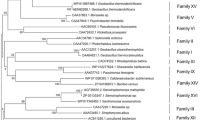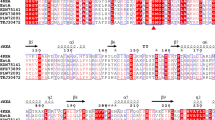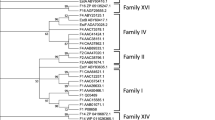Abstract
The estA gene encoding a novel cytoplasmic carboxylesterase from Arthrobacter nitroguajacolicus Rü61a was expressed in Escherichia coli. Sequence analysis and secondary structure predictions suggested that EstA belongs to the family VIII esterases, which are related to class C β-lactamases. The S-x-x-K motif that in β-lactamases contains the catalytic nucleophile, and a putative active-site tyrosine residue are conserved in EstA. The native molecular mass of hexahistidine-tagged (His6) EstA, purified by metal chelate affinity chromatography, was estimated to be 95 kDa by gel filtration, whereas the His6EstA peptide has a calculated molecular mass of 42.1 kDa. The enzyme catalyzes the hydrolysis of short-chain phenylacyl esters and triglycerides, and shows weak activity toward 2-hydroxy- and 2-nitroacetanilide. Its catalytic activity was inhibited by the serine-specific effector phenylmethylsulfonyl fluoride, and by Cd2+ and Hg2+ ions. Maximum activity of His6EstA was observed at a pH of 9.5 and a temperature of 50°C to 60°C. The enzyme was fairly thermostable. After 19 days at 50°C and after 24 hours at 60°C, its residual relative esterase activity toward phenylacetate was still 53% and 30%, respectively. Exposure of His6EstA to buffer-solvent mixtures showed that the enzyme was inactivated by several high log P (hydrophobic) solvents, whereas it showed remarkable stability and activity in up to 30% (by volume) of polar (low log P) organic solvents such as dimethylsulfoxide, methanol, acetonitrile, acetone, and propanol.


Similar content being viewed by others
Literature Cited
Arpigny JL, Jaeger KE (1999) Bacterial lipolytic enzymes: Classification and properties. Biochem J 343:177–183
Beadle BM, Trehan I, Focia PJ, Shoichet BK (2002) Structural milestones in the reaction pathway of an amide hydrolase: Substrate, acyl, and product complexes of cephalothin with AmpC β-lactamase. Structure 10:413–424
Berger R, Hoffmann M, Keller U (1998) Molecular analysis of a gene encoding a cell-bound esterase from Streptomyces chrysomallus. J Bacteriol 180:6396–6399
Dubus A, Monnaie D, Jacobs C, Normark S, Frère JM (1993) A dramatic change in the rate-limiting step of β-lactam hydrolysis results from the substitution of the active-site serine residue by a cysteine in the class-C β-lactamase of Enterobacter cloacae 908R. Biochem J 292:537–543
Dubus A, Normark S, Kania M, Page MGP (1995) Role of asparagine 152 in catalysis of β-lactam hydrolysis by Escherichia coli AmpC β-lactamase studied by site-directed mutagenesis. Biochemistry 34:7757–7764
Grant SGN, Jessee J, Bloom FR, Hanahan D (1990) Differential plasmid rescue from transgenic mouse DNAs into Escherichia coli methylation-restriction mutants. Proc Natl Acad Sci USA 87:4645–4649
Hanahan D (1983) Studies on transformation of Escherichia coli with plasmids. J Mol Biol 166:557–580
Holloway P, Trevors JT, Lee H (1998) A colorimetric assay for detecting haloalkane dehalogenase activity. J Microbiol Methods 32:31–36
Kim YS, Lee HB, Choi KD, Park S, Yoo OJ (1994) Cloning of Pseudomonas fluorescens carboxylesterase gene and characterization of its product expressed in Escherichia coli. Biosci Biotech Biochem 58:111–116
Kostichka K, Thomas SM, Gibson KJ, Nagarajan V, Cheng Q (2001) Cloning and characterization of a gene cluster for cyclododecanone oxidation in Rhodococcus ruber SC1. J Bacteriol 183:6478–6486
Laane C, Boeren S, Vos K, Veeger C (1987) Rules for optimization of biocatalysis in organic solvents. Biotechnol Bioeng 30:81–87
Laemmli UK (1970) Cleavage of structural proteins during the assembly of the head of bacteriophage T4. Nature 227:680–685
Lobkovsky E, Moews PC, Liu H, Zhao H, Frère JM, Knox JR (1993) Evolution of an enzyme activity: Crystallographic structure at 2-Å resolution of cephalosporinase from the ampC gene of Enterobacter cloacae P99 and comparison with a class A penicillinase. Proc Natl Acad Sci USA 90:11257–11261
Marchler-Bauer A, Bryant SH (2004) CD-Search: Protein domain annotations on the fly. Nucleic Acids Res 32:W327–W331
McKay DB, Jennings MP, Godfrey EA, MacRae IC, Rogers PJ, Beacham IR (1992) Molecular analysis of an esterase-encoding gene from a lipolytic psychrotrophic pseudomonad. J Gen Microbiol 138:701–708
Nishizawa M, Gomi H, Kishimoto F (1993) Purification and some properties of carboxylesterase from Arthrobacter globiformis: Stereoselective hydrolysis of ethyl chrysanthemate. Biosci Biotech Biochem 57:594–598
Nishizawa M, Shimizu M, Ohkawa H, Kanaoka M (1995) Stereoselective production of (+)-trans-chrysanthemic acid by a microbial esterase: Cloning, nucleotide sequence, and overexpression of the esterase gene of Arthrobacter globiformis in Escherichia coli. Appl Environ Microbiol 61:3208–3215
Oefner C, D´Arcy A, Daly JJ, Gubernator K, Charnas RL, Heinze I, Hubschwerlen C, Winkler FK (1990) Refined crystal structure of β-lactamase from Citrobacter freundii indicates a mechanism for β-lactam hydrolysis. Nature 343:284–288
Ogino H, Ishikawa H (2001) Enzymes which are stable in the presence of organic solvents. J Biosci Bioeng 91:109–116
Ogino H, Mimitsuka T, Muto T, Matsumura M, Yasuda M, Ishimi K, Ishikawa H (2004) Cloning, expression, and characterization of a lipolytic enzyme gene (lip8) from Pseudomonas aeruginosa LST-03. J Mol Microbiol Biotechnol 7:212–223
Ollis DL, Cheah E, Cygler M, Dijkstra BW, Frolow F, Franken SM, Harel M, Remington SJ, Silman I, Schrag J, Sussman JL, Verschueren KHG, Goldman A (1992) The α/β hydrolase fold. Protein Eng 5:197–211
Overhage J, Sielker S, Homburg S, Parschat K, Fetzner S (2005) Identification of large linear plasmids in Arthrobacter spp. encoding the degradation of quinaldine to anthranilate. Microbiology 151:491–500
Parschat K, Hauer B, Kappl R, Kraft R, Hüttermann J, Fetzner S (2003) Gene cluster of Arthrobacter ilicis Rü61a involved in the degradation of quinaldine to anthranilate: Characterization and functional expression of the quinaldine 4-oxidase qoxLMS genes. J Biol Chem 278:27483–27494
Petersen EI, Valinger G, Sölkner B, Stubenrauch G, Schwab H (2001) A novel esterase from Burkholderia gladioli which shows high deacetylation activity on cephalosporins is related to β-lactamases and DD-peptidases. J Biotechnol 89:11–25
Rainey FA, Ward-Rainey N, Kroppenstedt RM, Stackebrandt E (1996) The genus Nocardiopsis represents a phylogenetically coherent taxon and a distinct actinomycete lineage: Proposal of Nocardiopsaceae fam. nov. Int J Syst Bacteriol 46:1088–1092
Rost B, Yachdav G, Liu J (2004) The PredictProtein server. Nucleic Acids Res 32:W321–W326
Sambrook J, Fritsch EF, Maniatis T (1989) Molecular cloning: A laboratory manual. 2nd ed. New York: Cold Spring Harbor Laboratory Press
Trehan I, Beadle BM, Shoichet BK (2001) Inhibition of AmpC β-lactamase through a destabilizing interaction in the active site. Biochemistry 40:7992–7999
Wagner UG, Petersen EI, Schwab H, Kratky C (2002) EstB from Burkholderia gladioli: A novel esterase with a β-lactamase fold reveals steric factors to discriminate between esterolytic and β-lactam cleaving activity. Protein Sci 11:467–478
Zor T, Selinger Z (1996) Linearization of the Bradford protein assay increases its sensitivity: Theoretical and experimental studies. Anal Biochem 236:302–308
Acknowledgment
The authors thank Dr. Katja Parschat, Münster, for critical reading of this article.
Author information
Authors and Affiliations
Corresponding author
Rights and permissions
About this article
Cite this article
Schütte, M., Fetzner, S. EstA from Arthrobacter nitroguajacolicus Rü61a, a Thermo- and Solvent-Tolerant Carboxylesterase Related to Class C β-Lactamases. Curr Microbiol 54, 230–236 (2007). https://doi.org/10.1007/s00284-006-0438-2
Received:
Accepted:
Published:
Issue Date:
DOI: https://doi.org/10.1007/s00284-006-0438-2




